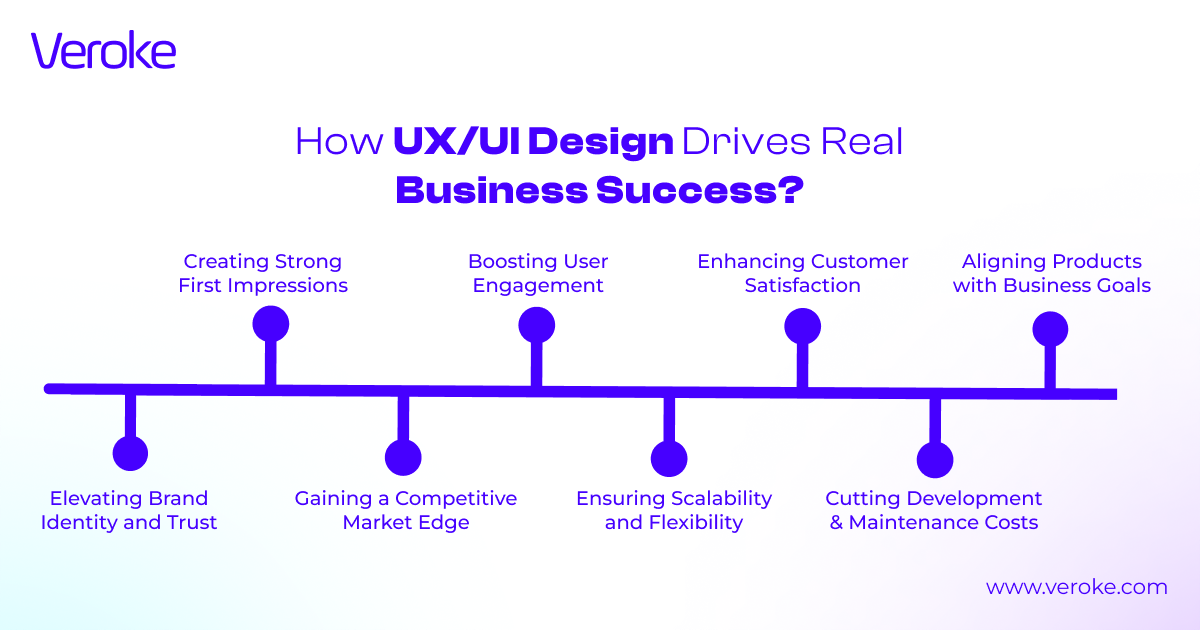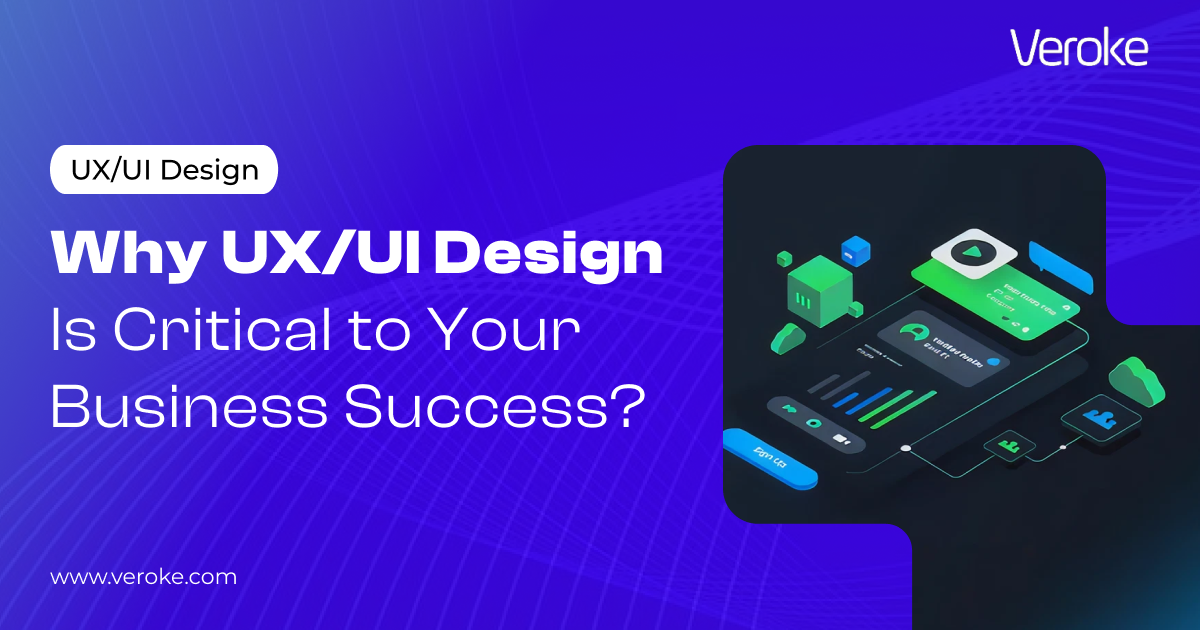Overview
Inside Saudi’s Tech Transformation
Get exclusive weekly insights into how the Kingdom is powering Vision 2030.
TL;DR
- UX/UI design is not just about visuals; it directly impacts user satisfaction, engagement, and business growth.
- A well-designed product builds trust, improves first impressions, and increases user retention.
- Good UX reduces friction, boosts productivity, and minimizes development rework and maintenance costs.
- Strategic UX/UI aligns digital products with business goals, enhances brand identity, and creates a competitive edge.
- Scalable design systems ensure long-term flexibility as products grow and evolve.
- Veroke Design Studio helps businesses build user-centered digital products that drive measurable results.
The first thing users notice about your digital product is not your backend code. It’s not even your business model. It’s your interface.
According to Forrester Research, on average, every $1 invested in UX results in a return of up to $100. Let that sink in.
In a world where 90% of users stop using an app due to poor performance, having a great product isn’t enough; it has to feel great, too.
And that’s where UI (User Interface) and UX (User Experience) come in.
Whether you’re building a customer-facing application or an internal enterprise tool, your interface and user experience can significantly impact how your product is perceived and its overall performance.
Let’s explore why UX/UI design plays a vital role in business performance and long-term growth, and how a strategic approach can give your company a significant edge over your competitors.
Understanding UX/UI and Why Should You Care?
UI is how your app looks. Like the buttons, typography, colors, layout, and the visual elements users interact with.
UX is how your app feels. It’s the journey users take, from clicking “Sign Up” to completing a purchase.
When thoughtfully executed, UX and UI together create seamless digital experiences that improve satisfaction, boost adoption, and increase productivity.
They determine how easy, enjoyable, and effective your product is to use.

1. Creating Strong First Impressions
When users interact with your platform for the first time, be it a customer portal, mobile app, or enterprise dashboard, the interface becomes an immediate reflection of your brand.
A cluttered layout, inconsistent visuals, or confusing navigation can make even the most innovative product feel unreliable. If you have developed a mobile app for your business, it can be intimidating for your business. On the other hand, a visually clean and well-organized interface builds immediate trust and sets the tone for a positive experience.
Today, digital is often the first and sometimes the only touchpoint. A strong first impression through UX/UI design reinforces your commitment to quality and professionalism, giving users a reason to engage further.
2. Boosting User Engagement
One of the most overlooked factors in digital transformation initiatives is product usability. Even the most feature-rich solution can underperform if users find it difficult to navigate or unintuitive to use.
Good UX design encourages deeper interaction with your product. It guides users through clear flows, reduces friction in completing tasks, and anticipates their needs before they encounter roadblocks.
When users feel in control, supported, and confident while using your platform, they are far more likely to return and integrate it into their routine.
For internal systems, this translates to increased employee productivity and reduced training time. For customer-facing applications, it boosts engagement, conversion, and repeat usage, all of which directly contribute to business performance.
3. Enhancing Customer Satisfaction
Exceptional UX/UI isn’t just about structure, it’s about how users feel. Think of micro-interactions, the small design details that confirm an action, show progress, or offer subtle delight. They may seem small, but they create a lasting impression.
Today’s users expect seamless digital experiences, fast, intuitive, and consistent. When a product just works, it reduces frustration, minimizes errors, and fosters satisfaction.
Accessibility is also essential in UX/UI design. Designing for everyone, including users with disabilities, ensures your product is inclusive, usable, and compliant with modern standards.
A smooth, accessible experience builds trust and long-term loyalty. Today, UX/UI isn’t just part of the customer experience; it is the experience.
4. Cutting Development & Maintenance Costs
Many businesses focus heavily on technical architecture during MVP development, but neglect UX/UI until later stages. This often results in avoidable rework, misaligned user flows, and increased time-to-market.
When design is prioritized from the beginning, it becomes a foundation for product development rather than an afterthought. Clear user journeys, functional wireframes, and early prototyping allow teams to identify challenges before they evolve into costly problems.
Additionally, a well-designed product requires less post-launch maintenance. By addressing user needs and behaviors upfront, you reduce the number of support tickets, user complaints, and redesign efforts that stem from usability issues.
In this way, UX/UI is not just an investment in better user experience; it’s an investment in operational efficiency.
5. Aligning Products with Business Goals
Every interface should be designed with clear business objectives in mind, whether it’s increasing conversions, streamlining internal workflows, or improving cross-team collaboration.
Thoughtful UX/UI helps bridge the gap between product functionality and user behavior through branding and the right design. It ensures that the design is not only usable but also strategically aligned with key outcomes.
For example:
- A financial services platform can use smart dashboard layouts to help users track spending or investments faster.
- A healthcare portal can simplify appointment booking with intuitive calendar flows and real-time availability.
- An internal HR system can reduce onboarding time through well-structured forms and guided workflows.
UX/UI design ensures that business logic is delivered to users in a clear, actionable, and efficient way.
6. Elevating Brand Identity and Trust
Design is one of the most powerful tools for shaping perception. A consistent visual language, across mobile, web, and desktop platforms, not only builds recognition but also differentiates your business in a crowded market.
A professional, modern interface communicates credibility. It signals that your company pays attention to detail, invests in quality, and understands user needs. This is especially important in enterprise environments where trust and reliability are non-negotiable.
When your competitors offer similar functionality, the design of your platform could be the reason a client chooses your solution over another. Good UX/UI is a competitive differentiator that reflects your business values.
7. Gaining a Competitive Market Edge
Today, technical capabilities are no longer the sole differentiator. Businesses across industries are offering comparable functionalities; what sets a platform apart is how intuitively and efficiently it delivers those capabilities to the end user.
When your product is easier to navigate, faster to interact with, and visually aligned with your brand identity, it naturally becomes the preferred choice.
In competitive sectors like fintech, healthcare, logistics, or enterprise SaaS, where users are comparing multiple platforms, a frictionless interface can be the deciding factor. It signals maturity, professionalism, and customer-centricity, qualities that matter deeply when winning enterprise clients or scaling operations.
8. Ensuring Scalability and Flexibility
As your organization grows, so do your platform’s requirements. You might expand into new regions, onboard more users, or add complex new features.
A scalable design system makes it easier to adapt to these changes without compromising usability. Reusable components, consistent UI patterns, and modular layouts help teams roll out updates faster and more efficiently.
In addition, UX/UI frameworks built with accessibility and responsiveness in mind ensure that your platform remains inclusive and usable, regardless of device or user type.
Planning for design scalability today helps you respond to future needs with agility and consistency.
Veroke Design Studio: Where Strategy Meets Design
At Veroke, we understand that great digital products are built on more than just clean code. That’s why we offer comprehensive UX/UI services through our dedicated Veroke Design Studio.
Our team combines design thinking, user research, and modern design principles to craft seamless digital experiences tailored to business goals. Whether you’re building a new platform, reimagining an existing solution, or integrating enterprise workflows, we design with purpose and precision.
Our process includes:
- In-depth discovery and user research
- Low- and high-fidelity prototyping
- Responsive and accessible UI design
- Design system creation and documentation
- Cross-functional collaboration with developers and stakeholders
With Veroke, you gain a strategic design partner who understands the nuances of enterprise-scale development and how to turn complexity into clarity.
Get in touch with us today to learn how the Veroke Design Studio can elevate your business through tailored UX/UI solutions that drive results.
Let us help you design digital experiences that are not just functional, but exceptional.
FAQs
1. Why is UI/UX design important for businesses?
UX/UI design is crucial for businesses because it directly impacts how users perceive and interact with a product. A well-designed interface boosts engagement, satisfaction, and conversions, while a poor one drives users away and harms brand reputation.
2. What is the main purpose of UX/UI design?
The main purpose of UX/UI design is to create products that are intuitive, efficient, and enjoyable to use. It focuses on enhancing user satisfaction by improving usability, accessibility, and overall experience.
3. How UX designers add value to a business?
UX designers add value by creating user-friendly experiences that boost customer satisfaction, increase retention, and drive conversions. They help align product design with user needs and business goals, reducing development costs and improving ROI.
Want to know more about our service.
Inside Saudi’s Tech Transformation
Get exclusive weekly insights into how the Kingdom is powering Vision 2030.
Transform your Ideas into a Digital Reality
Get scalable, customized solutions for your business.




